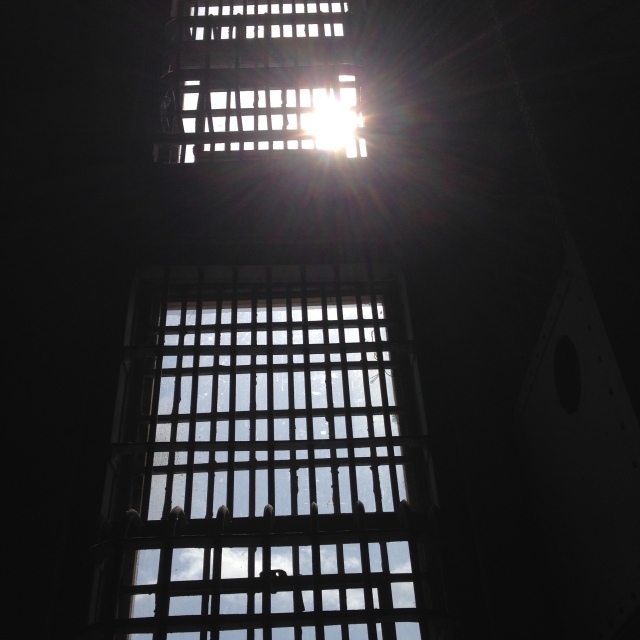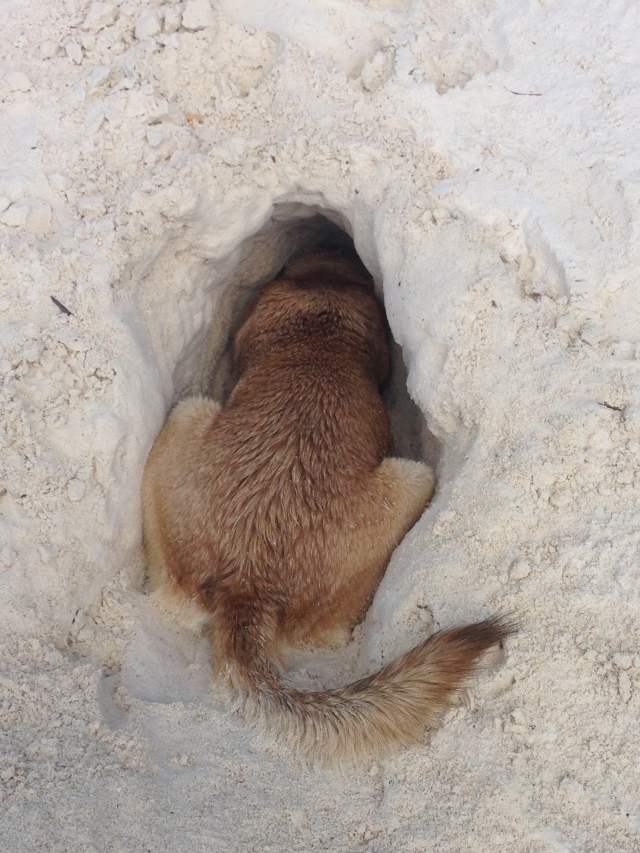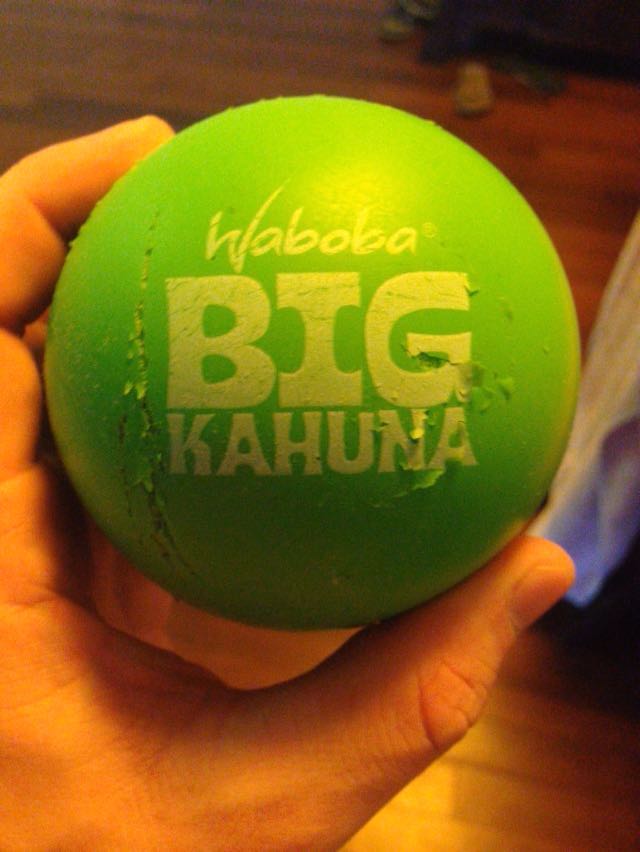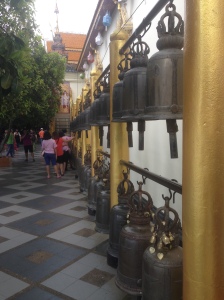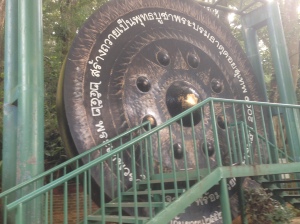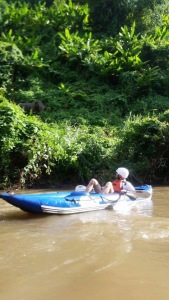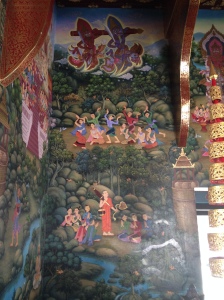Yosemite
The scale of the landscape in Yosemite is staggering. Our first glimpses from the car left us open-mouthed; vast granite cliffs commanded the valley sides while swathes of cedar and fir crowded the road. The atmosphere thickened.
We were aiming for a place called Housekeeping Camp – a congregation of three-sided concrete structures with canvas roofs, each hosting a picnic table, a stainless steel work station and a campfire grill. After a forty minute detour (it took us twenty to realise that the scenery appeared to be repeating itself) we eventually made it to the camp grounds, but until we found our plot there was nowhere to park. I sat in the car with the engine idling while Jo went to deal with the registration. I missed the first spot to free up because I was listening to the radio. I missed the second because I was still annoyed about missing the first. I didn’t miss the third, nor the scowl that came my way from the other guy vying for it. Inwardly I was impassive, outwardly I smiled…until I realised that I was doing those things the wrong way round and his scowl was hardening. I scuttled into the office quickly, before I accidentally flirted with or otherwise antagonised any more total strangers.
Half an hour later we were installed in our new campsite. It was getting late on an April afternoon, so the shadows were long and the air was cool. The camp was nestled into a meander of the Merced river; the glacial water flowed deep and cold, and sharp, strong currents scattered looping eddies that flared across its clear black surface. Across the river there was an attractive strip of sandy beach bathed in the evening sun, and shafts of light scored the still quiet. Only the occasional bird or sharp crack of catching firewood broke the silence – otherwise, sound was muted by soft carpets of pine needles and the whispering branches above. We took pictures of the river and our surroundings, then went for a stroll to the village shop to get our bearings and some supplies.
That evening we cooked our first camp meal together, which was exciting as we had planned well and stocked up on plenty of supplies. To keep us fuelled on our trip we had packed enough fresh food to create a variety of meals, including salads, a Bolognese, a Thai curry, bacon and eggs and home-made burgers, and the village shop helped us with extras like butter and salt and vinegar crisps (whose availability in a village shop in the back end of nowhere signals that America is a civilised nation after all).
We had to keep all the supplies, even toiletries, locked in a bear-bin as black bears (oddly named, as these ones are apparently brown) will take anything within easy reach, including shampoo and other scented beauty products. This gave me an inadvertent opportunity to annoy the neighbours as I almost wilfully kept forgetting this or that utensil or ingredient, and so had to make several return trips, clanging and banging in and out of the heavy metal bear-bin all the while. Sitting by the blazing fire we ate well and drank beer while the air cooled and the stars came out. The tone was set.
The next day, rested and full of energy, we were ready to hike. We rose early after a decent night’s sleep – the temperature plummeted after the light faded, but we had two sleeping bags, a duvet and armfuls of blankets, so the cold didn’t really bother us. We ate a hasty breakfast of granola and yoghurt, got some information about trails from the camp-ground office, then headed out: we opted for the Vernal Fall and Nevada Fall trails, which would lead us 2,000 feet up to the foot of the Half-Dome trail (5,000 feet above sea level). Unfortunately this was closed due to ice, but in any case the walk took us the whole day, with the occasional break. (Half-Dome is an imposing 8,800 foot peak that looms over the Nevada Falls. It has one smooth, rounded side and one sheer cliff-face, hence its name, and in the summer you can take a trail to its shoulder and then climb a cable route up to the top.)
The early part of the hike was pleasant and undemanding. The skies were clear blue and the birds were busily flitting about their day. The path wound gently but firmly up until it reached the foot of the Vernal Falls. On the way there was a sober warning – one summer not long before a young boy had been playing in a pool of the river that looked calm and placid, only to be caught in a current and swept to his death downstream. The water is shallow and clear at the edges, and the the surface of this particular pool betrays little evidence of the submerged boulders and turbulence beneath.
The higher we got, the steeper the climb became, but also the greater the rewards. Each turn in the path brought us a new, ever more impressive view of the ring of mountains and cliff faces, their broad immensity demanding pause. As we rounded yet another bend we saw Vernal Falls ahead, its spray forming a faint but unmistakable rainbow curtain a hundred feet in the air. Despite this, we joked that we were climbing into Mordor as we began to ascend the steps that would lead us to the top of the waterfall: its spray soaked the rocks so that they were a grim, textured grey and the sun was temporarily shut out by the lip of the valley ridge. It got dark, cold and wet before it got light again, but the trail was busy and people were courteous as they let each other pass to and fro on the steep steps.
After a decent climb we reached the waterfall itself, turned, and yet again the quality of the view appreciated by degrees.The rest of that hike, an 8 mile loop served up a conveyor belt of nature’s majesty, as interpreted by Yosemite valley. Birds hung for minutes at a time in thermal vents hundreds of feet above; trees sprang from unlikely cracks in vertical cliff faces; boulders as big as tractors, some as big as houses littered the trails; and rainbows smudged in and out of view as we ascended and descended through the mist formed by spraying torrents of melt-water.
We sat at the top of Vernal Falls for a break and had a coffee. Jo had brought a new camping toy called a Jet Boil, which will have you scalding your hands and making a mess of whatever surface you set it boiling on in minutes. Though that was more to do with our inability to keep a close eye on it than any failing of the device. During our break we embarrassed ourselves a little by letting it boil over, sending coffee grounds flooding over the rocks where we sat, but we employed a healthy supply of baby-wipes to clean it up and then spent a hugely enjoyable half an hour doing the crossword and taking in the spectacular scenery – and at this stage we were still only half way into our climb. What we didn’t know then was that the next climb, which took us to the top of Nevada falls, would give us a view out over the entire valley, as well as putting us in sight of Half Dome, Liberty Cap and Mt Broderick. This time we sat for lunch and whiled away well over an hour munching, chatting and drooling over the views. One particular feature that kept drawing the eye was the vertical striping in shades of grey, red and brown on some of the rocks; all around there were miniature waterfalls cascading over the lips of the cliffs, and these had exactly the same patterning as the stripes elsewhere. It was tempting to think that over the course of the last few tens of thousands of years various such waterfalls have flowed and stemmed, leaving behind a painted canvas of granite. However they were caused, they were yet another intriguing and beautiful component of a landscape that was by now, frankly, showing off.
That night we made the Thai curry. We had made the paste already at the Thai evening we had enjoyed not long before (see US Adventure Part I), so it was all home cooked and fresh. At around nine o’clock a couple of late-arrivals to the camp came wandering past looking for their cabin, just as I shone my torch onto the pan bubbling away over the hot coals. It smelled good, it looked good and these guys had clearly had a long day. One of them told me how good it looked and smelt as he walked by. He seemed friendly. He smiled. I bared my teeth and hissed. He moved off. He wasn’t the only person to risk a mauling that night: I woke up the next morning looking for beef jerky and eventually found it stuffed in the bottom of my bag, which I had left right next to my bed. Fortunately we didn’t receive any unwelcome visitors. The bears probably saw the way I scared off those guys who eyed up my dinner earlier.
The next day we were understandably tired, and so were looking for something a little less strenuous to do. This time the rangers in the office pointed us in the direction of Tuolumne Grove, a stand of Giant Sequoias about a half hour drive from our campsite. At the entrance to the trail around the grove there is a model of a Sequoia stump. It is around ten feet across and its rings are labelled with key events: its first year of growth, The Battle of Hastings, the discovery of America, the sinking of the Titanic, and so on. This is as arresting as you would expect, and put me back in the philosophical mood of the drive into Yosemite the day before; equally arresting, though less impressive, is the ruthless efficiency with which industrial logging decimated Redwood populations from the mid 19th century onwards. Now the Sequoias have to cope with climate change as well, which some researchers believe could wipe out the remaining island populations throughout California within the century. For a species of tree that has evolved for millions of years to a point where it can reasonably expect a lifespan of up to two thousand years (one was estimated to be as old as 3,200), this is fairly appalling to contemplate.
The circular trail around the grove is only a couple of miles long, and after only a few hundred metres we spotted our first Sequoia. A mere fifteen feet in circumference and only around thirty metres high this was a baby, but it still towered over its peers (thirty metres is about the same as a ten story building – the tallest can get to 25-30 stories, which is sky-scraper territory). After that the wonders came thick and fast: one mature tree that had been toppled naturally lay dead, its trunk ten feet tall and a hundred and fifty feet long; another prominently displayed a gnarled root system and the hollow inside was large enough to crawl through (we did; it was dark and full of potential spiders, which are like normal spiders only harder to spot); yet another dead stump has been burnt out and tunnelled through, and stands guardian over the trail providing a great photo opportunity – as long as you are patient and prepared to wait for the young children in the family ahead to completely ignore this wonder of nature as they squabble over who has the biggest stick, and why this may or may not be entirely fair. I suspect the irony of this discussion was probably lost on them. The meddling parents generously gave the debate about five minutes to run its course but it had the potential to go on indefinitely if they hadn’t intervened. Then at the head of the loop, we stumbled upon a stand of around twenty thriving Giant Sequoias. It is difficult to describe how big a Giant Sequoia really is up close. I could give you more comparisons, but how many of them would give you a true sense of their size? If I told you that you wouldn’t fit one on a tennis court, would that help? Or that it would take you about four seconds to fall from the top branches to the hard, hard ground below? Suffice it to say, that the awe we experienced the day before was well-matched here. It seems that in Yosemite there is a competition in progress: the tallest, the deepest, the widest, the grandest, the most turbulent, the most serene…the rivalry is fierce, and everything is winning.
On our way home the next day, Jo stopped the car at a viewing point. Sheer cliffs rose up to our right while a steep slope fell away into the valley to our left. We wanted to have one last look at Yosemite before leaving, so we clambered down the scrubby, loose shingle slope until we found a suitable rock to perch on. Far below the river was frothy and treacly-slow, high above birds wheeled endlessly, and everywhere was perfectly still.In the peaceful calm we sat, and basked, and silently watched.











































